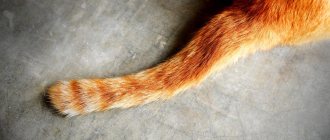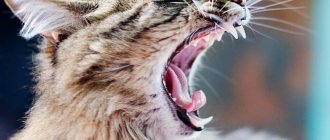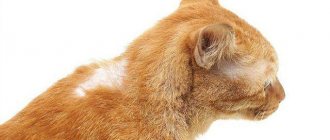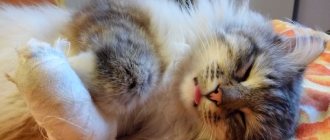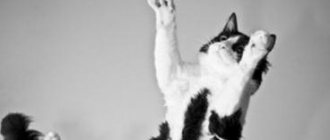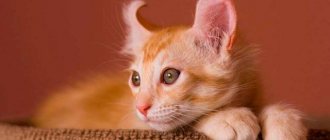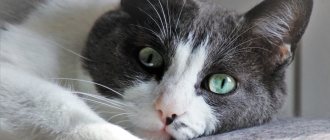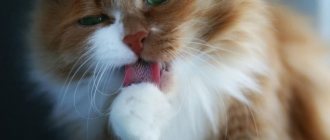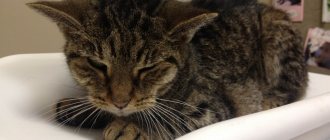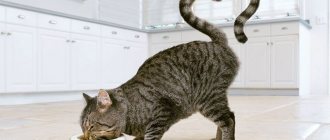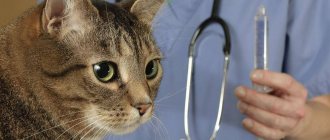There are diseases in cats that can frighten even the most experienced animal breeders and their owners. One of these diseases is convulsions in a cat that occur suddenly, and what to do, how not to get confused and panic at the sight of your pet convulsing, is what we will have to figure out in this article.
Convulsions in animals are very similar to an epileptic seizure in humans, and may even be accompanied by loss of consciousness. What are the causes of this condition in a cat?
Mechanism of seizures
Convulsive twitching of the paws or the whole body is always frightening.
Especially if you don’t know the nature of this phenomenon. This behavior is not typical for animals. Seizures are a dangerous pathology that is not an independent disease.
Muscle spasms are a sign that some organ or system of the animal has malfunctioned and affected the functioning of the brain.
How does this happen
By nature, cats have tissues and ligaments of the muscular system that are quite elastic. That’s why they manage to change so quickly from a relaxed state to an active one and vice versa. This transition is so smooth that it is difficult to notice from the outside.
But convulsions immediately catch the eye. At the same time, the cat not only twitches the body or individual areas - muscle cramps are accompanied by painful spasms.
Twitching can be single or repeated at regular intervals. But spasms always come suddenly and manifest themselves in different ways.
Types of seizures in cats
| Type | How it manifests itself |
| Convulsive | Mild twitching or muscle contractions are observed. The pet responds adequately to the owner |
| Tonic | Short-term, but repeated slow muscle contractions with a certain periodicity. The cat behaves restlessly, not just meows, but howls |
| Clonic | Contractions alternate with relaxation. The cyclicity is about 30-120 seconds. During convulsions, the pet falls on its side, and in the intervals between them makes attempts to move |
| Epileptic | The cat's muscles are constantly tense, he himself is in an unconscious state, often with his eyes open. If relaxation occurs, it lasts a few seconds. |
The last type of seizure is the most dangerous, as it usually ends in the death of the animal..
But even convulsive twitching does not go unnoticed for the pet. Therefore, it is important, with the help of a specialist, to determine the cause that provoked the seizures and try to eliminate it.
Types of seizures in cats
There are the following types of seizures:
- Tonic. There is an intense contraction of skeletal muscles, lasting a short period of time.
- Clonic. The muscles tense and contract. 1 leg or all 4 legs of the animal twitch violently. This type is characteristic of damage to the central nervous system.
- Mixed or tonic-clonic. Characteristic of cats suffering from epileptic seizures. Often occur with systemic intoxication of the body.
Causes of convulsions
All types of muscle contractions indicate that there are many factors that provoke symptoms.
To make it easier to make a diagnosis and carry out targeted treatment, the predetermining causes are divided into groups:
factors associated with brain dysfunction;- reasons that led to disruptions in the metabolic processes of the cat’s body;
- intoxication.
These are based groups that include entire lists of diseases in which sudden convulsions and seizures are possible.
Each cause of muscle contractions should be considered in detail so that you know what you have to face.
Forms of the disease
Similar problems are caused by the following reasons:
- Damage to kidney tissue;
- Dysfunction of urine drainage;
- Blockage of blood flow to the kidney tissues;
- Ingestion of toxic substances into the body.
The peculiarity of the acute form is that timely treatment can completely cure and restore the functional characteristics of a cat’s healthy kidneys. However, with frequent repetitions of acute deficiency, it can become chronic.
Kidney failure in cats is a serious and difficult to treat disease. It occurs in older and older animals. Often the chronic type of disease occurs due to kidney obstruction and other related ailments. With correct diagnosis and timely intervention, it is possible to alleviate the course of the disease and associated symptoms.
With brain damage
Pathologies affecting this organ are the most dangerous. Defeat can be caused by both external factors and internal processes.
Causes
| Disease | Peculiarities |
| Tick-borne encephalitis | When an ixoid tick bites, an infection enters the cat's body with the insect's saliva, causing the disease. Characteristic signs other than seizures:
|
| Hypoxia | Oxygen starvation can occur for a number of reasons, but in any case it leads to damage to brain tissue. At first, the symptoms are mild, and the seizures are so short-lived that the owner may simply not notice them. As the pathology develops, the number of convulsions and their duration increase. Hypoxia can be suspected by suddenly appearing shortness of breath, fainting, or cyanosis of the mucous membranes. |
| Rabies | Not just dangerous - a fatal disease caused by Babes Negri bodies. The animal's hind legs twitch first, then its limbs become paralyzed. While the cat is able to move, it shows strong aggression. The disease develops rapidly. Spasms pass from the body muscles to the respiratory muscles, and the animal dies from suffocation |
| Tumors | The initial stage of oncology has no obvious symptoms. They will appear when the tumor, growing, begins to put pressure on important areas of the brain. The animal's behavior changes: the cat becomes aggressive, loses orientation - constantly bumps into walls, objects, and monotonously circles in one place. The disease is often accompanied by convulsive seizures |
| Hydrocephalus | The cause is disruption of the outflow of fluid from the brain. The pathology is congenital and can be detected at an early stage. A kitten suffering from hydrocephalus has a larger skull volume than healthy babies, and it lags behind its brothers in development. The disease manifests itself as clonic convulsions, the first signs of which can be noticed at 2 months of age. The rapid development of pathology leads to death |
| Hematomas, injuries | Damage to the skull is accompanied by profuse vomiting. With severe injuries, loss of consciousness, paralysis of a group of muscles and twitching of those that hold the eyeballs are possible. |
Even an unbalanced diet, which provokes the development of vitamin deficiency, can cause brain damage.
In particular, this concerns vitamin B1 (thiamine), which is necessary for the smooth functioning of systems. The initial stage is manifested by trembling of the limbs; with severe deficiency, convulsions are observed.
Treatment options for seizures
When a seizure occurs, a diagnosis is carried out: the veterinarian does a blood test, prescribes an x-ray or ultrasound. Instrumental and laboratory tests make it possible to establish a diagnosis and draw up a treatment regimen.
To relieve seizures, anticonvulsants are prescribed:
- Primidon. A potent and highly toxic medication helps prevent seizures in dogs and cats when they are life-threatening. Give to the animal in the dosage strictly specified by the veterinarian. Exceeding the daily norm threatens systemic poisoning and creates a high load on the liver.
- Phenobarbital, Pagluferal. Used in emergency situations. Intravenous or intramuscular injections act directly on the neuromuscular system and have a pronounced muscle relaxant effect. The drugs are prohibited from being taken on an ongoing basis, because active substances will accumulate in the blood. The result is an overdose.
The regimen and dosage of medications is determined depending on the weight, breed of the animal, the presence of chronic diseases, and the etiology of seizures. It is strictly forbidden to suddenly stop taking medications. Otherwise, a relapse is possible.
In addition to anticonvulsants, a number of other medications are prescribed to eliminate the underlying disease. Acute poisoning is treated with diuretics and absorbent agents. In case of brain damage, multivitamin complexes and antibiotics are prescribed to destroy the infection. Disorders of general metabolism are relieved with the help of dietary supplements and diet therapy.
Metabolic disorders
Failures in the functioning of internal systems disrupt metabolism and the rhythm of metabolic processes. This leads to an imbalance in the nervous system, and impulses are sent to the muscles “incorrectly,” which manifests itself in convulsions.
Metabolism-related diseases
| Name | Peculiarities |
| Eclampsia | It is observed during the period of gestation of kittens, at birth and feeding. A convulsive state develops against the background of a sharp decrease in the level of calcium in the blood and is accompanied by severe pain. In the initial stage, convulsive twitching is observed in the hind limbs. As the attacks progress, they become more frequent and affect the entire body. |
| Kidney failure | There are many factors that provoke this disease, from common infections to autoimmune pathologies. Failure of the kidneys interferes with the removal of toxins from the body. As a result, brain tissue is damaged. |
| Hypoglycemia | Blood glucose levels drop sharply. Convulsive attacks are accompanied by severe pain, causing the animal to writhe and scream loudly. This condition is similar to epileptic seizures |
| Intoxication | Toxic substances that enter a cat’s body have a negative effect on the nervous system. In mild cases, this provokes stool upset. In severe situations, intestinal bleeding is added to diarrhea. The cat is vomiting and writhing in convulsions |
Any disruption of metabolic processes if assistance is not provided in a timely manner will lead to the death of the pet.
Old age can also be included in this group of pathologies. In the body of old cats, degenerative processes occur that affect almost all organs, but the brain is the first to suffer.
Involuntary muscle twitching may be pre-death convulsions.
Preventive measures to avoid new attacks
To reduce the likelihood of recurrence of attacks, it is necessary to provide your pet with comfort. Timely bathing, treatment of parasitic pathologies and infections, and maintaining cleanliness in the apartment can reduce the risk of developing seizures by 35%. The owner must adjust the animal’s diet depending on the type of feeding:
- Dry food. It is recommended to purchase products of “premium” and “super premium” classes. Cheap food does not contain the multivitamin complex necessary to maintain the animal's metabolism.
- Natural homemade food. 90% of the diet should be meat and dairy products. It is not recommended to give your cat milk or cream. The remaining 10% is plant foods: vegetables, fruits and unleavened cereals. They should be mixed with meat so that the cat receives all the necessary complex of vitamins and mineral components.
If necessary, you can add vitamin solutions to the water. It is not recommended to get a new pet within a year after the first attack. Cats do not always accept other pets on their territory.
Acquaintance is accompanied by stress, which can lead to dyspeptic disorders, cardiovascular pathologies and disruption of the nervous system. As a result, this reaction provokes the re-development of seizures.
Other reasons
There are other factors that do not fit into the structure of known groups. They are also dangerous and can cause death.
Postoperative period
Surgical interventions are accompanied by the administration of painkillers, anesthesia and other medications to the animal. If the operation was performed incorrectly or the dosage was incorrectly selected, the body may react to this with convulsions.
When prescribing medications, the doctor must take into account their individual intolerance.
Epilepsy
A systemic disease associated with changes in brain activity is always difficult, with severe, painful seizures and can result in the death of the pet at any time.
The pathology can be hereditary or develops against the background of trauma, inflammation of the membranes of the brain, or cancer.
Stress
Convulsive contractions are short-term in nature, accompanied by aggressive behavior and lack of appetite. This is due to strong stimulation of the nervous system after experiencing emotional shocks.
A cat can be stressed by bathing, moving, or the arrival of a new animal or small child in the house. In uncastrated pets, seizures may begin due to unsatisfied sexual instinct.
The main symptoms of a convulsive state
Often, signs of impending seizures in a cat can be noticed even before they begin. The animal becomes restless, does not find a place for itself, meows loudly, tries to stay close to the owner or, on the contrary, hides in a secluded place.
Convulsions are usually divided into clonic and tonic. The former are characterized by a rhythmic alternation of short-term sharp muscle contractions and relaxations. Such cramps are less painful, and in mild cases they look like muscle twitching. Tonic spasms are prolonged tension of a muscle group without a change in its strength.
When convulsions occur due to severe muscle spasms, the cat experiences pain, screams, its pupils are dilated, its limbs are tense in a bent or straightened state, or it makes chaotic movements. A large amount of saliva or foam may come out of the mouth. Uncontrolled urination or bowel movements are also possible. The cat does not react to its surroundings. Sometimes during convulsions the animal loses consciousness, although the respiratory function is usually not impaired.
A seizure usually lasts 3-5 minutes. When it ends, the animal may behave normally, or may look agitated and somewhat disoriented, or, on the contrary, experience slight weakness, lethargy, and a desire to sleep.
What symptoms should you be wary of?
Any deviation in the animal’s usual behavior should be alarming.
To prevent seizures from becoming a surprise, you need to pay attention to the accompanying signs:
- uncontrolled urination;
- involuntary defecation;
- dilated pupils;
- flow of saliva or foam from the mouth.
It happens that an animal shows aggression, does not respond to the owner’s voice, and does not allow itself to be touched. This behavior is due to the fact that the cat is frightened by a sudden attack and severe pain.
How to care for your pet?
Caring for a dying cat requires effort, time and patience. She needs to be provided with a comfortable and soft place to rest. A cozy and warm lounger can be made from a blanket. Two rules must be followed:
- Regularly monitor the cleanliness of the sleeping area by washing the bedding daily.
- If an old cat cannot control urination, then lay disposable diapers over a soft base, changing them as they get dirty.
When an animal does not have enough strength to go to the toilet, you need help. To do this, he is carried by hand to the tray every 3–4 hours.
You should not violate the cat’s privacy if he tends to distance himself and does not respond to affection.
It is important to relieve your pet's pain symptoms. Cats rarely scream, meow, or otherwise show their distress. But they can be recognized if the following signs are present:
- decreased sociability and detachment;
- immobilization;
- looking at one point;
- dilated pupils;
- refusal to drink and eat;
- intermittent breathing.
First aid: owner actions
In such situations, a person’s self-control plays an important role. Timely measures taken will help save the life of a pet:
- During an attack, the cat must be carefully laid on a flat surface, which is covered with oilcloth or rags. At the same time, you cannot forcibly hold it, so as not to provoke unnecessary stress. You should not unclench your jaws, so as not to injure the animal.
During an attack, it is recommended to administer an anticonvulsant and analgesic to your pet. They do this by injection, and not by mouth: convulsions that seize the muscles of the larynx will not allow the cat to swallow the medicine, and it will simply choke.- A light massage will help ease the spasm. It is carried out on areas of the body affected by convulsions.
Even a small isolated attack is already a reason to urgently take your pet for examination. Convulsive muscle contractions don’t just happen. There needs to be a reason for this, and each of them is dangerous.
First aid for seizures
Owners of sick cats should be able to provide first aid at the time of an attack. They then need to be taken to a veterinary clinic. The main task is to provide the animals with peace and eliminate the possibility of injury due to spasms.
The main actions of the owner should be as follows:
- prevent the animal from falling by placing it on the floor on a soft bedding. Remove all piercing and cutting objects, close the curtains, muffle loud sounds;
- Make sure your head is turned to the side to avoid choking on saliva;
- If possible, lightly massage the limbs and body to reduce the activity of spasms;
- calm down yourself and calm the animal with affection and words of consolation;
- Carefully monitor the animal’s behavior in order to subsequently give a detailed description to the doctor.
If a cat experiences convulsions for the first time, he should be taken to the vet immediately. The doctor must conduct a thorough diagnosis in order to understand the causes of spasms. After the necessary appointments have been made, the owner’s main task is to give the pet medications according to the schedule, carefully following the veterinarian’s recommendations.
Treatment: basic measures
Therapy for convulsive states is necessary in any case, but it is prescribed only after examining the animal. Therefore, all treatment is divided into stages.
Step one - diagnosis
The doctor asks the owner how the attacks manifested themselves and what they were accompanied by. When compiling an anamnesis, it is important to know what the cat ate the day before, how it behaved, and whether there were stressful situations or injuries.
Blood and urine tests are taken from the animal. The cat is sent for hardware examination (ultrasound, MRI). Only after collecting all the results does the doctor move on to the next stage.
Step two - choosing treatment tactics
In each specific case, an individual course of therapy is selected. First of all, it is necessary to act on the factor that provoked the cat’s seizures. Often an epileptic attack is stopped with Promidon.
Symptomatic treatment includes the following:
- prescription of analgesics;
- antiemetics;
- solutions that prevent dehydration;
- vitamin complex.
You can quickly eliminate cramps with Pagliferal or Phenobarbital.
But these injections are done only in a clinic under the supervision of a doctor, since the drugs are toxic and an overdose cannot be allowed.
Convulsions or epileptic seizure?
We have already mentioned epilepsy several times. What is it and how can you distinguish epileptic seizures from “regular” seizures? Currently, many researchers propose to consider it not one disease, but a syndrome that combines different pathologies that can cause functional disorders of brain activity.
When it comes to differentiation, things are complicated. It is believed that with a single seizure it is impossible to talk about epilepsy, but nevertheless seizures (a characteristic sign of both seizures and epilepsy) become more frequent over time, so they are not a reliable differential sign. Without a number of diagnostic studies (which we will discuss below), it is impossible to make an accurate diagnosis.
But! In everyday life, it is believed that an epileptic seizure cannot develop in a dream: such seizures are more typical during periods of wakefulness. Ordinary convulsions occur at any time.
Preventive measures
Prevention will help you avoid problems related to your pet’s health:
- diet with the selection of balanced feeds;
immunization and deworming of the animal;- regular treatment against parasites;
- timely treatment of infectious diseases.
Preventive visits to the veterinarian 1-2 times a year will help to promptly identify and eliminate diseases of internal organs and systems.
What to feed a cat with cholecystitis?
When treating cholecystitis, your pet must be switched to a special balanced diet. It is recommended to continue the diet until the cat’s condition is completely restored. This takes about 2-4 weeks.
It is necessary to completely exclude fried and fatty foods with a high cholesterol content from the animal’s diet: lamb, sausages, butter, canned fish, condensed milk, etc.
Products that can be included in your cat's diet:
- low-fat meat or fish broth,
- rice or oatmeal porridge,
- rice water,
- boiled vegetables (carrots, potatoes),
- lean minced chicken,
- light cottage cheese.
Diagnostics
Since convulsive syndrome is not an independent disease, but serves as one of the symptoms of any dysfunction of organs and systems, muscle spasms can be eliminated only by curing the underlying disease.
When determining the cause of seizures in a cat, a carefully collected medical history is of great importance. If you bring your pet to the veterinarian with complaints of recurring muscle convulsions, be prepared to answer a number of questions comprehensively:
- when the first seizures were noticed;
- how often they are repeated;
- what type of seizures are they: short-term or long-term;
- at what time attacks most often occur: during sleep, after waking up, after eating or physical activity;
- what does the animal eat;
- does the cat have chronic somatic diseases?
- whether she has recently had an acute illness, and if so, what medications she has taken;
- whether your pet has had a history of head injuries;
- if the cat’s pedigree is known, does it indicate cases of idiopathic (congenital) form of epilepsy.
If a diagnosis cannot be made by studying the history and visual examination of the animal, or if it requires clarification, the veterinarian will prescribe a series of laboratory and instrumental tests for the cat. These may include:
- Clinical blood test. Allows you to detect the inflammatory process that has developed in the body.
- Biochemical blood test (will determine the level of potassium, calcium, magnesium in the blood serum). Blood sugar test. Needed to rule out diabetes in a cat.
- General urine analysis and urine analysis according to Nechiporenko. Allows you to identify liver and kidney diseases of infectious or non-infectious origin.
- Cerebrospinal fluid analysis. A lumbar puncture is performed if there is a suspicion of inflammation of the spinal membranes or a tumor in the brain area.
- Electrocardiogram. Certain changes on the ECG are observed with hypokalemia.
- Chest X-ray and/or ultrasound examination of the abdominal organs: gallbladder, liver, kidneys, pancreas, spleen.
- Magnetic resonance imaging of the brain. It is carried out to detect a tumor or morphological changes in brain tissue.
What should an owner do during cat seizures?
No matter how scary the owner is at the sight of his beloved pet convulsing, he will have to take care of him. First, protect your cat from objects around him that can injure him.
It will be good if you can wrap your cat in a blanket and thus ensure his safety from injury. At the same time, you need to hold it lightly, and the warmth from the blanket will also ease the pet’s condition.
The owner must also not forget about his safety and his hands must be reliably protected. A cat during a convulsive attack may not recognize its owner, be in a state of aggression and scratch or even bite him.
The duration of a seizure attack is usually no more than four minutes. When it’s over, the pet should be reassured with gentle words and under no circumstances left alone in the room. The cat will need some time to recover from the fright of what happened.
Convulsions that occur in a cat for the first time should not be ignored. If they passed in four minutes, then there is no need to call a veterinarian at home or run to him immediately. But this incident should not be left unattended and the cat should be shown to a specialist in the near future. If the seizures lasted much longer and recurred several times, the cat should be placed in a closed carrier and taken to a veterinary clinic.
You don’t need to feed or water your pet immediately after the seizure ends, but a bowl of water should be within the cat’s reach so that he can easily reach it and drink if he wants.
